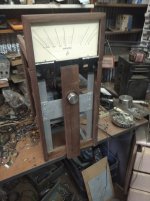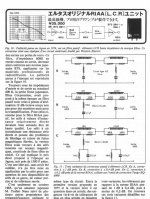I understand that it is an expensive brand, but still, no one will pay that amount for just junk.
You know, not especially, I had the opportunity to listen to an amplifier with a TND of 0.005 percent. True, a transistor and a tube with 4-5%. The first was a lifeless, sterile sound. I didn't want to listen to more than 1 disc. I listened to the second for many hours, the only thing that irritated me was the need to go and turn over or change discs every 20 minutes.So you don’t care about distortion?
I see there is a single coupling capacitor and some others in the power supply. The type of these capacitors have big influence on the subjective sound quality (even if the measurements, THD etc. do not reflect it). What capacitors do you use? AN used some copper foil or silver foil and paper in oil if I remember correctly.
Hi,
You are not reasoning, but just stating Your personal taste/view.
Too bad, You are not entering into a factuous discourse, even though You claim longtime experience.
Citing AN as a reference is revealing though .... they are known to be sounding devices within their small special niche ... which is perfectly ok in this luxury item market.
But one won't find them where exactness, neutrality and signal fidelity are the primal goals.
In one regard You're right ... one can't discuss with believers about beliefs.
jauu
Calvin
You are not reasoning, but just stating Your personal taste/view.
Too bad, You are not entering into a factuous discourse, even though You claim longtime experience.
Citing AN as a reference is revealing though .... they are known to be sounding devices within their small special niche ... which is perfectly ok in this luxury item market.
But one won't find them where exactness, neutrality and signal fidelity are the primal goals.
In one regard You're right ... one can't discuss with believers about beliefs.
jauu
Calvin
I think that the capacitor right after the kenotron determines the sound of the device. I like the paper capacitor, from the USSR. It gives the sound of expensive brands, at least not worse. They can still be bought at our flea markets. For 1-2 $ I stocked up on 100 pieces.. Тип этих конденсаторов оказывает большое влияние на субъективное качество звука
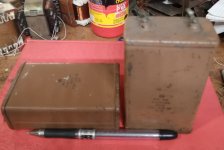
You know, I am not a professor of electronics. I have a chemistry degree. Making vacuum tube devices is my hobby. If I report something, these are my own observations and feelings. And not what I read on the Internet. I want to share my experience. I only listen to LP discs; the sound of CDs is unacceptable to me. That's how it is.Вы не рассуждаете, а просто излагаете свой личный вкус / точку зрения.
I don't understand the term in the topic "RIAA LR correction".
I know only RC resp. CR networks (usual in use) and LCR networks in RIAA stages.
if you mean such LCR networks ("RIAA LCR correction"), check out the URL's in post #8 under
https://www.analog-forum.de/wbboard...k-welche-prinzipiellen-unterschiede-existier/
LR correction networks (i. e. without capacitors) in RIAA stages I have never seen until now.
I know only RC resp. CR networks (usual in use) and LCR networks in RIAA stages.
if you mean such LCR networks ("RIAA LCR correction"), check out the URL's in post #8 under
https://www.analog-forum.de/wbboard...k-welche-prinzipiellen-unterschiede-existier/
LR correction networks (i. e. without capacitors) in RIAA stages I have never seen until now.
I do not speak English. I am communicating with you through a translator. Perhaps he translates clumsily .... The LR correction implies to me that only L-inductors and R-resistors participate in it. Without C capacitors. . There is only one capacitor in the circuit. It had to be installed only because of the large internal resistance of 12SС7. . It is not possible to wind a transformer for it. Although I wind them myself.Я не понимаю термин в теме "Коррекция RIAA LR".
Sorry, I'm a braggart. The link shows my products and the photo shows what's currently in progress https://ok.ru/profile/563212304004/album/908248405380Что меня впечатляет, так это профессиональное качество дизайна и изготовления готовых устройств.
.
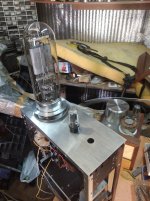
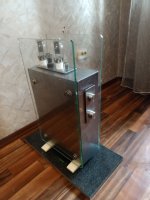
Attachments
Last edited:
check out this image (from an article in french language, from J.Hiraga)I do not speak English. I am communicating with you through a translator. Perhaps he translates clumsily .... The LR correction implies to me that only L-inductors and R-resistors participate in it. Without C capacitors. . There is only one capacitor in the circuit. It had to be installed only because of the large internal resistance of 12SС7. . It is not possible to wind a transformer for it. Although I wind them myself.
There is no variant without capacitor if input and output impedance is constant.
P.S.: the unwanted sound signature of capacitors without caps in the RIAA network don't provide any benefit, because in your circuit the 0,15/0,22uf caps in the signal pad also provide it's own sound signature (not only through it's high pass character).
Attachments
Last edited:
Well , no matter what , there 's a lot that 's not there .In the diagram at the beginning of M 10 , it is there . There 's a lot that's not there . Here is a diagram of the Lichnitsky corrector with the correction performed on the transformer . I wanted to repeat it earlier, but there is no time. There is a lot of variety in life . http://aml.spb.ru/articles/rx_corrector.htm
http://aml.spb.ru/articles/rx_corrector.htm
 http://aml.spb.ru/articles/rx_corrector.htm
http://aml.spb.ru/articles/rx_corrector.htm
Last edited:
So you don’t care about distortion?
So if you don't care about distortion why the phobia about capacitors?You know, not especially
You must have nightmares about straight wires.
Trolling is not good .снятся кошмары о прямых проводах.
There are some LR Riaas (correctors) out there.
Steve Bench has done one.
Pete Millet has done one.
and so on...
All of them I have heard sound very good.
It is a very interesting circuit Anatoly shared with us!
Thank you
Steve Bench has done one.
Pete Millet has done one.
and so on...
All of them I have heard sound very good.
It is a very interesting circuit Anatoly shared with us!
Thank you
There are some LR Riaas (correctors) out there.
Below is an image of the EMIA LR Phono Corrector (LRPC).
And here is the manufacturer's webpage: https://myemia.com/LR.html
P.S. It doesn't come cheap, especially if you desire silver windings!!
Neither is attributing to people words which they did not utter.Trolling is not good .
@ejp: please stop reacting the way you do.
In the field of audio It does not make sense to question personal opinions.
The way we perceive sound is an individual thing; you might not like what I like.
Many people prefer tube electronics over solid state and we know there is more "measurable" distortion in the former, but apparently it does not always work that way when we listen with our ears.
On L(C)R RIAA equalization: read http://www.pmillett.com/LR_phono.html.
Pete is a highly regarded and creative EE (there are not so many of those).
I built his LR phono preamp; sounds great.
In the field of audio It does not make sense to question personal opinions.
The way we perceive sound is an individual thing; you might not like what I like.
Many people prefer tube electronics over solid state and we know there is more "measurable" distortion in the former, but apparently it does not always work that way when we listen with our ears.
On L(C)R RIAA equalization: read http://www.pmillett.com/LR_phono.html.
Pete is a highly regarded and creative EE (there are not so many of those).
I built his LR phono preamp; sounds great.
It's good that the guy likes the result of his own work...he may or never really understand why, but it's ok for the moment.
That design has lots of tubes loaded by the riaa network and that is what you are hearing, the loaded tubes.If you place that load after an op amp you'll probably hear a very neutral solid state like sound...Tubes being capacitive in nature likes to be loaded by inductive networks so they compliment each other, that is true.It's very close to the effect a step up transformer has on electrostatic headphones.Also LCR networks are usually lower noise than RC ones.
That design has lots of tubes loaded by the riaa network and that is what you are hearing, the loaded tubes.If you place that load after an op amp you'll probably hear a very neutral solid state like sound...Tubes being capacitive in nature likes to be loaded by inductive networks so they compliment each other, that is true.It's very close to the effect a step up transformer has on electrostatic headphones.Also LCR networks are usually lower noise than RC ones.
No, only the input tube is loaded by the RIAA network and anode resistor; the other tubes are merely for gain and don't see the RIAA network.That design has lots of tubes loaded by the riaa network and that is what you are hearing, the loaded tubes
- Home
- Source & Line
- Analogue Source
- RIAA Phono LR correction
